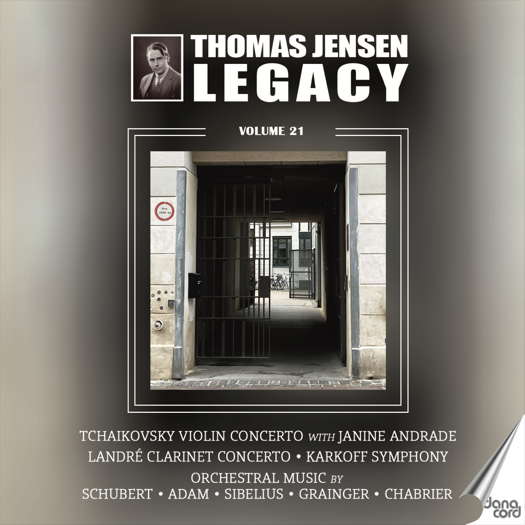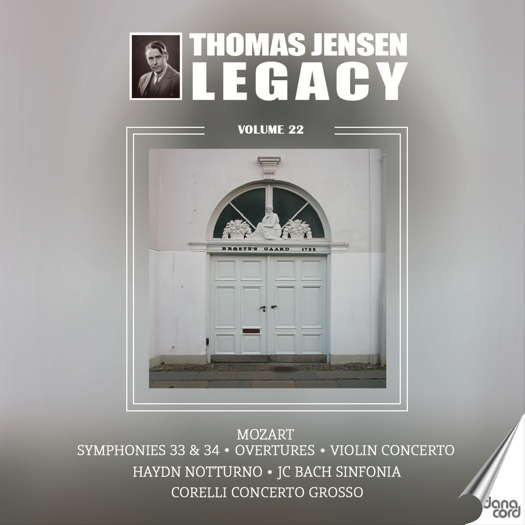 SPONSORED: An Integral Part - Lindsey Wallis looks forward to the Canadian Music Centre's tribute concert to composer Roberta Stephen.
SPONSORED: An Integral Part - Lindsey Wallis looks forward to the Canadian Music Centre's tribute concert to composer Roberta Stephen.
All sponsored features >>
- Cypriano de Rore
- Victor Herbert
- Helsinki
- Alfred Schnittke
- Franz Dimmler
- Takahiro Sonoda
- Mozart: Violin Concerto No 4 in D
- Ian Stephens: Springhead Echoes
 DISCUSSION: John Dante Prevedini leads a discussion about Classical Music and Politics, including contributions from Béla Hartmann and James Ross.
DISCUSSION: John Dante Prevedini leads a discussion about Classical Music and Politics, including contributions from Béla Hartmann and James Ross.

Consistently Engaging
GERALD FENECH listens to two more volumes in Danacord's 'Thomas Jensen Legacy' series
'... Jensen in joyous mood ...'
Presenting performances from the last two years of Thomas Jensen's life, this collection exposes the immensity of his repertoire, and also the wonderful versatility of his orchestra, which was capable of adapting itself to the interpretative personalities of different conductors in canon repertoire, giving heartfelt and accurate renditions of new music, and turning to rarities such as the suite by Geirr Tveit. The series of Sunday Concerts was programmed as a lighter alternative to the Thursday Concerts, although there was a good deal of repertoire common to both series, such as Tchaikovsky's Violin Concerto, heard in this broadcast from April 1962.
The French violinist Janine Andrade (1918-1997) is almost forgotten today, though as a pupil of Carl Flesch and Jacques Thibaud at the Paris Conservatoire, she had the kind of top-ranking training that developed her as a musically sensitive virtuoso with an individual timbre. Her career had to wait until after the War and centred on her native France, before it was tragically cut short by a stroke in 1972.
Listen — Tchaikovsky: Canzonetta, Andante (Violin Concerto)
(DACOCD 931 CD1 track 2, 1:19-1:55) ℗ 2024 Danacord Records :
Not for nothing did Hindemith give the title of Symphonic Metamorphosis rather than Variations to the orchestral work he wrote while in wartime exile in the USA. A ballet project with Leonide Massine came to nothing, and Hindemith treated his chosen themes from Weber's music with an extreme virtuosity of invention, perhaps with the technical polish and finesse of US orchestras in mind.
A Danish Radio Symphony Orchestra concert in November 1961 presented even more recent music, including the Clarinet Concerto by the Dutch composer Guillaume Landré. First taught by his father Willem and then by distinguished composer and pedagogue Willem Pijper, Landré developed a chromatic-tonal idiom bearing less of a resemblance to Hindemith than to the more austerely contrapuntal 'metamorphosis' techniques of Vagn Holmboe and Nils Bentzon, as heard in previous instalments of this Jensen series.
Listen — Guillaume Landré: Clarinet Concerto
(DACOCD 931 CD1 track 9, 2:00-2:58) ℗ 2024 Danacord Records :
In this same concert Jensen conducted the Third Symphony of Maurice Karkoff, another figure now almost completely forgotten. Born in Stockholm, Karkoff studied with Lars-Erik Larsson and then later with composers as diverse as Luigi Dallapiccola, André Jolivet and Max Deutsch.
Listen — Maurice Karkoff: Symphony No 3, Op 38, Sinfonia breve
(DACOCD 931 CD2 track 2, 5:09-5:55) ℗ 2024 Danacord Records :
Returning to the Sunday-series concert which included Tchaikovsky's Violin Concerto, Geirr Tveit himself presented the first of his suites of Hardanger Folk Tunes, with explanation and demonstrations of the original songs much to the amusement of the studio audience. With these suites, Tveit aimed to preserve a Norwegian tradition of singing and storytelling in the mould of Bartók in Hungary and Bulgaria, Launy Grondahl in Denmark and Percy Grainger in England. The suite sketches everyday life in homes, churches and fields, through vignettes of a wedding, a drinking song, blackberry-picking and so on.
Listen — Geirr Tveit: Mulberries and Blackberries (Hardanger Suite No 1)
(DACOCD 931 CD2 track 6, 0:00-0:28) ℗ 2024 Danacord Records :
The concert also featured Grainger's best-known free arrangement of a folk song, 'Country Gardens', alongside a trio of lighter works beginning with the brilliant rhapsody-evocation of Spain, España by Chabrier.
This Volume 21 in this cycle also includes music by Schubert, Sibelius, Bentzon and Adam. Do not mind the rather ordinary sonics which is to be expected, considering that these recordings were made in 1961 and 1962 from studio recordings and live broadcasts. The music-making is electrifying and this issue is another demonstration of how brilliant Jensen was when on the podium, even when he was in his early sixties. Strongly recommended for Jensen aficionados and those who love to explore pastures new.

Thomas Jensen's connection with the Danish Radio Symphony Orchestra deepened during the early 1950s. The Orchestra had come to international attention in concerts led by Fritz Busch at the 1950 Edinburgh Festival, and given a critically acclaimed account of Nielsen's Fourth in London under Launy Grondahl the following year. In 1952 they embarked on an ambitious tour of the USA, giving thirty-nine concerts in thirty-eight cities over forty-seven days. The punishing schedule did not suit the ageing Grondahl, and the orchestra's members petitioned for Jensen to replace him.
Sharing duties with Erik Tuxen, Jensen conducted twenty performances of Nielsen's Fourth, as well as works by Dvořák, Grieg and Richard Strauss. This led to a part-time post with the orchestra in 1953, and when Grondahl retired in 1956 and Tuxen died the following year, Jensen was finally offered the coveted chair of permanent conductor in the autumn of 1957.
However, Jensen, now close to sixty, was not the conductor he had been twenty-five years earlier, when he auditioned unsuccessfully for the post. He had begun to suffer from progressive deafness, and he humbly remarked to the musicians that his appointment with them might have come a little too late. The orchestra was also beginning to feel the pressure of success, which demanded both more concerts and a more challenging repertoire, leaving its musicians less time to rehearse and perform the international repertoire that had made them more renowned both in Denmark and beyond.
Until Jensen's sudden and early death on 13 November 1963, he and the orchestra made a heroic effort to preserve and pass on a vast-vanishing heritage. They were the guardians of a performing culture derived from Nielsen and from the orchestra's distinguished early conductors. After 1963, years passed without the Danish Radio Symphony Orchestra engaging a permanent conductor, and both its playing and esprit de corps suffered accordingly. Still, this priceless series has kept this tradition alive while representing something of a last gasp of a lost age in the history of Danish twentieth century music.
As one can surmise from previous issues, Jensen was an all-encompassing conductor who excelled in all kinds of period music, be it baroque, classical, romantic and maybe that most close to his heart, twentieth century music.
Listen — Mozart: Allegro molto (Symphony No 34 in C, K 338)
(DACOCD 932 CD1 track 10, 0:00-0:58) ℗ 2024 Danacord Records :
This Volume 22, which groups together works by Corelli, Haydn, J S Bach and Mozart, finds Jensen in joyous mood and these performances are consistently engaging while displaying Jensen's ability to adapt himself to a wide range of musical emotions with wholesome conviction.
Listen — Corelli: Allegro (Concerto grosso Op 6 No 3 in C minor)
(DACOCD 932 CD2 track 5, 1:18-2:06) ℗ 2024 Danacord Records :
The Jensen treasure-trove keeps growing and growing. Hopefully, the end of the tunnel is still far away. Remasterings and annotations are state-of-the-art.
Copyright © 8 May 2024
Gerald Fenech,
Gzira, Malta



